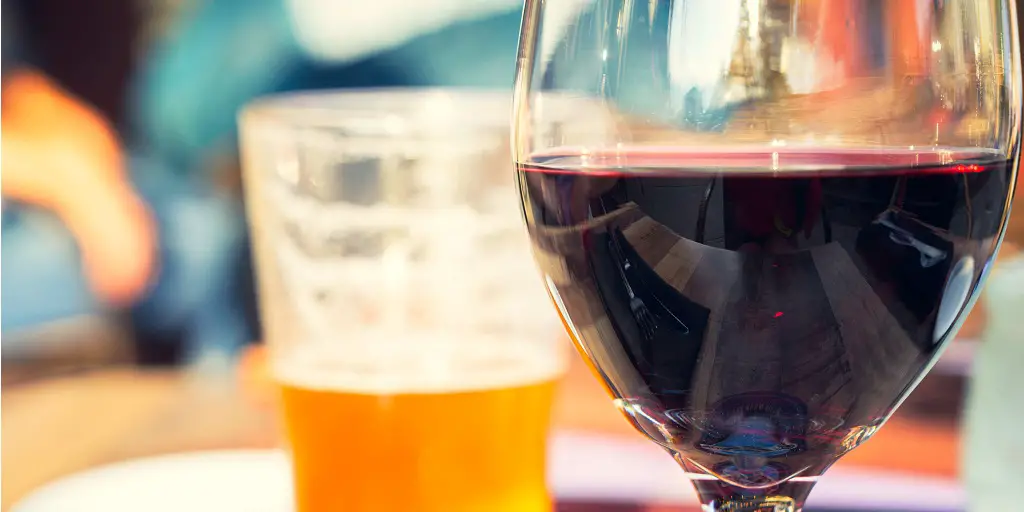Wine and beer are two of the most popular alcoholic beverages in the world, each with a rich history and a passionate following. When comparing wine to beer, it’s essential to consider several aspects, including taste, health benefits, variety, food pairings, and cultural significance. In this article, we’ll explore these aspects to understand the nuances that make each beverage unique and beloved by many.
Taste and Variety
Wine is celebrated for its vast range of flavors, which are influenced by the grape variety, soil, climate, and winemaking techniques. From the crisp acidity of a Sauvignon Blanc to the deep, complex notes of a vintage Bordeaux, wine offers a diverse palette of tastes that can appeal to many preferences. Wine’s flavor is often described in terms of its body (light, medium, or full), acidity, sweetness, and tannins, which contribute to its overall profile and complexity.
Beer, on the other hand, also boasts an impressive variety, with styles ranging from light and refreshing lagers to rich and complex stouts and ales. The flavor of beer is shaped by its ingredients (water, malt, hops, and yeast) and the brewing process. Hops add bitterness to balance the sweetness of the malt, while yeast can contribute a range of flavors, from fruity to spicy. The craft beer movement has further expanded beer’s flavor spectrum, introducing innovative brews with unique ingredients and techniques.
Health Benefits
Both wine and beer have been studied for their potential health benefits, often linked to moderate consumption.
Wine, particularly red wine, is famous for its content of antioxidants like resveratrol, which has been associated with heart health benefits, including reducing the risk of heart disease and certain cancers. However, it’s crucial to note that excessive consumption can negate these benefits and lead to health issues.
Beer is not without its health merits. It contains vitamins, minerals, and antioxidants, although in different proportions than wine. Beer, especially darker brews, can offer significant amounts of dietary silicon, important for bone health. Like wine, the key is moderation, as overconsumption can lead to health problems.
Food Pairings
Both beverages offer versatile pairing options with food, enhancing dining experiences.
Wine pairings are well-established, with certain wines complementing specific dishes — for example, red wines with red meat and white wines with fish or poultry. The acidity, sweetness, or tannins in wine can balance the flavors of the food, making for a harmonious dining experience.
Beer pairings have gained recognition for their ability to complement a wide range of dishes. The carbonation in beer can cleanse the palate, making it a great partner for fatty or rich foods. Craft beers, with their diverse flavor profiles, can be paired meticulously with dishes to highlight both the food and the beer.
Cultural Significance
Wine has a profound cultural significance, often associated with tradition, sophistication, and ritual. Its history spans thousands of years, with deep roots in civilizations around the Mediterranean and beyond. Wine is central to many cultural practices and celebrations, symbolizing wealth, status, and communal bond.
Beer also holds a significant place in many cultures, historically associated with social gatherings, festivals, and community events. It’s often viewed as a more casual, accessible beverage, integral to the social fabric of many societies. The brewing of beer dates back thousands of years, with each region developing its own styles and traditions.
Choosing between wine and beer is a matter of personal preference, as each offers unique flavors, health benefits, and cultural significance. Whether you prefer the complex taste profiles and health benefits associated with wine or the rich variety and social aspect of beer, both beverages have their place in the world of gastronomy and culture. Ultimately, the best choice is the one that brings you the most enjoyment and complements your lifestyle and taste preferences.
Sustainability and Production
An additional aspect to consider in the wine vs. beer debate is sustainability and the environmental impact of production. Both industries are increasingly focusing on sustainable practices, but there are inherent differences in their environmental footprints.
Wine production can be resource-intensive, requiring large amounts of water and land. Vineyards are sometimes criticized for their use of pesticides and fertilizers, though there is a growing movement towards organic and biodynamic wines that emphasize environmental stewardship. The glass packaging of wine also adds to its carbon footprint, although many wineries are exploring lighter bottles and more sustainable packaging solutions.
Beer brewing is also water-intensive, but many breweries are implementing innovative water-saving technologies and recycling processes. The ingredients for beer, such as barley and hops, generally require less land than vineyards. Craft breweries often lead in sustainability efforts, adopting practices like solar power, waste reduction, and local sourcing of ingredients. Beer’s packaging, which includes cans, is often cited as more eco-friendly due to the recyclability and lighter weight of aluminum compared to glass.
Economic Impact
The economic contributions of the wine and beer industries also play a role in their societal value.
Both sectors create jobs, stimulate agriculture, and contribute to local and global economies.
Wine has a significant impact on tourism, with wine regions around the world attracting visitors for tastings, tours, and events. This not only supports local economies but also promotes cultural heritage and education about winemaking traditions.
Beer, particularly through the rise of craft breweries, has revitalized local economies, creating jobs and fostering community development. Breweries often become community hubs, supporting local events and charities, and contributing to the vibrancy of neighborhoods.
Accessibility and Consumption Trends
The accessibility and consumption trends of wine and beer reflect their place in society and consumer preferences.
Wine is sometimes perceived as more exclusive or intimidating due to its complex terminology and vast range of styles. However, efforts to demystify wine and make it more approachable are broadening its appeal. Wine clubs, tastings, and educational resources have made wine more accessible to a wider audience.
Beer is often seen as more universally accessible, with a laid-back image that appeals across demographics. The craft beer movement has also introduced a level of sophistication and experimentation to beer, attracting enthusiasts interested in exploring unique and artisanal brews.
Personal Discovery and Enjoyment
Ultimately, whether wine or beer is “better” comes down to personal discovery and enjoyment. Each beverage offers a world of flavors, experiences, and traditions to explore. Here are a few suggestions for those looking to deepen their appreciation:
Attend Tastings: Both wine and beer tastings are great ways to explore different styles and find what you enjoy.
Pair with Food: Experiment with pairings to discover how wine or beer can enhance different dishes.
Learn the Craft: Understanding the production process, from the vineyard to the brewery, can deepen your appreciation.
Explore Locally: Support local wineries and breweries to discover unique offerings and learn more about the craft in your area.
In conclusion, wine and beer each have their virtues, offering diverse and rich experiences. Whether you lean towards the elegance and tradition of wine or the creativity and community of beer, the most important factor is the joy and satisfaction derived from each sip. So, why not enjoy both, depending on the occasion, mood, and preference? After all, variety is the spice of life.
FAQ on Wine vs. Beer
Is wine healthier than beer?
The health benefits of both wine and beer are most often linked to moderate consumption. Red wine is well-known for its antioxidants, such as resveratrol, which may offer heart health benefits. Beer, particularly darker ales and stouts, contains its own set of nutrients, including B vitamins, fiber, and silicon, which are beneficial for bone health. The key to reaping health benefits from either beverage is moderation and consumption as part of a balanced diet.
Can beer be as sophisticated as wine?
Absolutely. The craft beer movement has elevated beer to a level of sophistication that rivals wine.
With an emphasis on artisanal brewing techniques, unique ingredients, and an endless variety of styles, craft beers can offer complex flavor profiles that are appreciated by connoisseurs and casual drinkers alike. Beer tastings and pairings are becoming as nuanced and detailed as those for wine.
What are the best foods to pair with wine and beer?
Wine and beer both offer versatile pairing possibilities. For wine, traditional pairings include red wines with red meats and white wines with lighter dishes like fish and poultry. Sparkling wines are excellent with salty or fried foods, while sweet wines complement desserts well.
Beer’s carbonation makes it an excellent match for rich and fatty foods, as it cleanses the palate.
Lighter beers pair well with delicate flavors like seafood and salads, while darker beers complement hearty dishes, smoked foods, and chocolates.
How does the alcohol content compare between wine and beer?
Generally, wine has a higher alcohol content than beer. The average alcohol by volume (ABV) for wines ranges from about 12% to 15%, while most beers are around 4% to 6% ABV. However, there are exceptions, with some craft beers and specialty wines venturing outside these ranges.
Are there eco-friendly options for wine and beer?
Yes, both industries are increasingly focusing on sustainable practices. For wine, look for organic, biodynamic, and sustainably farmed labels that minimize environmental impact. In the beer world, many craft breweries are leading the way in sustainability, using local ingredients, minimizing water usage, and implementing recycling programs. Choosing local options can also reduce the carbon footprint associated with transportation.
How do I get started with exploring wine or beer?
Start by tasting different styles to find what you enjoy. Visiting local wineries and breweries, attending tasting events, or joining clubs can provide opportunities to learn and discover new favorites. Reading about wine and beer, from production methods to tasting notes, can also enhance your appreciation and understanding.
Can wine and beer be part of a healthy lifestyle?
Yes, when consumed in moderation, both can fit into a healthy lifestyle. It’s essential to balance consumption with a healthy diet and regular exercise. Always be mindful of the guidelines for moderate drinking to ensure that your enjoyment of wine or beer does not negatively impact your health.
Wine and beer each have their own unique charm and complexities, appealing to a wide range of tastes and preferences. Whether you’re drawn to the nuanced artistry of winemaking or the innovative spirit of craft brewing, there’s a whole world of flavors and experiences waiting to be explored.
Remember, the best beverage is the one that brings you pleasure and fits your lifestyle, so why not enjoy both and discover the diverse joys they offer?




